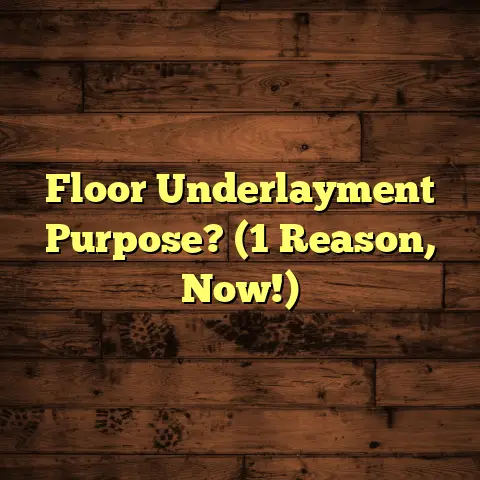Remove Tile Floor With Drill? (5 Min Demo!)
I’m excited to share a game-changing technique that will make your tile removal project a breeze.
I’m talking about using a drill!
Trust me, I know the thought of tile removal can send shivers down your spine.
I’ve been there, staring at a floor of outdated or damaged tiles, dreading the back-breaking work ahead.
But what if I told you there’s a faster, more efficient way?
A way that can save you time, energy, and a whole lot of frustration?
Stick with me, and I’ll show you how to remove tile flooring using a drill in what feels like a 5-minute demo.
But first, let’s talk about why this project is so important, even beyond the aesthetic upgrade.
The Health Benefits of a Fresh Start
Let’s be real: a beautiful home is great.
But a healthy home? That’s priceless.
Outdated or damaged flooring can be a breeding ground for allergens, bacteria, and other nasties that can negatively impact your indoor air quality and overall health.
Think about it:
-
Dust and Allergens: Old tile can trap dust, dirt, and allergens, which can trigger respiratory issues like asthma and allergies. Every time you walk across that floor, you’re kicking those particles into the air, creating a less-than-ideal breathing environment.
-
Mold and Mildew: Cracks and damaged tiles provide the perfect environment for mold and mildew to thrive. These sneaky invaders can release spores into the air, leading to respiratory problems, skin irritation, and other health issues.
-
Psychological Well-being: Let’s not forget the mental benefits of a fresh, clean space. A modern, updated home can reduce stress, improve your mood, and create a sense of calm and well-being. I’ve personally felt the difference after completing a renovation project. It’s like a weight lifted off my shoulders.
According to the EPA, indoor air can be two to five times more polluted than outdoor air. Removing old tile and replacing it with a clean, new surface is a simple way to improve your indoor air quality and create a healthier living environment.
Section 1: Understanding Tile Flooring
So, what exactly are we dealing with here?
Tile flooring is a hard-wearing surface covering made from various materials.
The most common types I encounter include:
-
Ceramic Tile: This is a classic choice, known for its durability and affordability. It’s made from clay that’s fired at high temperatures, making it resistant to scratches and stains.
-
Porcelain Tile: A denser and more durable option than ceramic, porcelain is ideal for high-traffic areas and is often used in bathrooms and kitchens due to its water resistance.
-
Vinyl Tile: This is a more budget-friendly option that’s easy to install and maintain. It’s available in a wide range of styles and colors and is often used in basements and laundry rooms.
-
Other Materials: You might also encounter stone tiles (like granite or marble), glass tiles, or even metal tiles, each with its unique properties and installation requirements.
Now, why would you want to rip out perfectly good-looking (or not-so-good-looking) tile?
There are plenty of reasons:
-
Damage: Cracked, chipped, or broken tiles can be unsightly and even dangerous.
-
Outdated Styles: Let’s face it, some tile styles just don’t age well. If your flooring is stuck in the ’70s or ’80s, it might be time for an upgrade.
-
Renovation Plans: Maybe you’re remodeling your kitchen or bathroom and want to create a new, cohesive look.
-
Underlying Issues: Sometimes, tile needs to be removed to address underlying issues like water damage or subfloor problems.
Before you start swinging a hammer, it’s crucial to assess the type of tile and adhesive used.
This will significantly impact the removal process.
Some adhesives are easier to break than others.
Some tiles are more brittle than others.
Knowing what you’re up against will save you time and frustration in the long run.
Section 2: The Health Benefits of Removing Old Tile Flooring (Revisited)
I touched on this earlier, but it’s worth diving a little deeper into the health benefits of removing old tile flooring.
Let’s get specific:
-
Allergen Reduction: As I mentioned, old tile can trap dust, dirt, and allergens. According to the American Lung Association, reducing allergens in your home can significantly improve respiratory health, especially for those with asthma or allergies.
-
Mold and Mildew Prevention: Mold and mildew thrive in damp, dark environments. Cracked or damaged tiles provide the perfect breeding ground. Removing these tiles and addressing any underlying moisture issues can prevent mold growth and improve indoor air quality.
-
Improved Air Quality: A study by the Environmental Protection Agency (EPA) found that indoor air can be two to five times more polluted than outdoor air. Removing old flooring and replacing it with a clean, new surface can significantly reduce indoor air pollution and improve your overall health.
-
Reduced Stress: A clean, organized, and aesthetically pleasing home can have a profound impact on your mental well-being. Studies have shown that clutter and disorganization can increase stress levels and negatively impact mood. Removing old, outdated flooring and replacing it with a modern, clean surface can create a more relaxing and inviting living space.
I’ve seen firsthand how a simple flooring upgrade can transform a home and improve the lives of its occupants.
It’s not just about aesthetics; it’s about creating a healthier, happier living environment.
Section 3: Tools and Equipment Needed for Tile Removal
Alright, let’s get down to business.
Here’s what you’ll need to tackle this project:
-
Electric Drill: This is the star of the show! A standard electric drill with variable speed settings will do the trick. I prefer a cordless drill for added mobility, but a corded drill will work just fine.
-
Tile Removal Bit: This is a specialized drill bit designed to break up tile and mortar. There are several types available, including:
- Carbide-Tipped Drill Bits: These are durable and effective for drilling through most types of tile.
- Diamond-Tipped Drill Bits: These are ideal for harder tiles like porcelain and stone.
- Mortar Removal Bits: These are designed to grind away mortar and grout.
-
Safety Gear: Safety first, always! You’ll need:
- Gloves: To protect your hands from sharp edges and debris.
- Goggles: To protect your eyes from flying tile shards and dust.
- Mask: To protect your lungs from dust and airborne particles. I recommend an N95 respirator mask for optimal protection.
-
Hammer or Chisel (if needed): These might be necessary for stubborn tiles or for cleaning up edges.
-
Dustpan and Broom (or Shop Vac): For cleaning up the inevitable mess. A shop vac is your best bet for quickly and efficiently removing dust and debris.
Quick Tip: Before you start, make sure your drill is fully charged (if cordless) and that you have all your tools within easy reach. There’s nothing more frustrating than having to stop mid-project to hunt down a missing tool.
Section 4: Preparing the Area for Tile Removal
Preparation is key to a successful tile removal project.
Here’s what you need to do:
-
Clear the Workspace: Remove all furniture, rugs, and other obstacles from the area. This will give you plenty of room to work and prevent damage to your belongings.
-
Safety First: Turn off the electricity to any outlets or circuits near the tiles you’ll be removing. Water and electricity don’t mix, so it’s always better to be safe than sorry. Ensure proper ventilation by opening windows and doors. This will help to minimize dust and fumes in the air.
-
Protect Adjacent Surfaces: Cover any adjacent surfaces, such as walls, cabinets, or flooring, with plastic sheeting or drop cloths. This will protect them from dust, debris, and accidental damage. I like to use painter’s tape to secure the plastic sheeting in place.
-
Plan Your Attack: Take a few minutes to assess the situation and plan your approach. Identify any potential problem areas, such as tiles that are particularly difficult to reach or areas with a lot of grout.
Section 5: Step-by-Step Guide to Removing Tile Flooring with a Drill
Alright, let’s get to the fun part!
Here’s a step-by-step guide to removing tile flooring with a drill:
Step 1: Assess the Tile and Adhesive
As I mentioned earlier, it’s crucial to determine the type of tile and adhesive you’re dealing with.
This will help you choose the right drill bit and removal strategy.
-
Tile Type: Is it ceramic, porcelain, vinyl, or something else? Harder tiles like porcelain will require a more aggressive drill bit and more patience.
-
Adhesive Type: Is it a thin-set mortar, a mastic adhesive, or something else? Some adhesives are easier to break than others. You can usually get a sense of the adhesive type by chipping away at the grout and examining the material underneath.
Step 2: Mark the Tiles
Use a marker or pencil to mark the tiles you’ll be removing.
This will help you keep track of your progress and avoid accidentally damaging adjacent tiles.
I like to draw an “X” across each tile I’m removing.
Step 3: Drill the Tiles
This is where the magic happens!
-
Start with a Pilot Hole: Use a carbide-tipped drill bit to drill a pilot hole in the center of the tile. This will help to prevent the tile from cracking or chipping.
-
Switch to the Tile Removal Bit: Once you have a pilot hole, switch to your tile removal bit. Hold the drill at a slight angle and begin drilling around the pilot hole, creating a series of overlapping holes.
-
Drill Strategically: Focus on drilling along the grout lines and around the edges of the tile. This will help to weaken the bond between the tile and the subfloor.
-
Apply Gentle Pressure: Don’t force the drill. Let the bit do the work. Apply gentle, consistent pressure and allow the drill to slowly grind away at the tile.
-
Work in Sections: Divide the tile into smaller sections and drill each section thoroughly. This will make it easier to remove the tile in pieces.
Important Tips:
-
Wear Safety Gear: Always wear gloves, goggles, and a mask when drilling tile.
-
Use a Vacuum: Use a shop vac to suck up dust and debris as you drill. This will help to keep your workspace clean and prevent dust from spreading throughout your home.
-
Don’t Overheat the Bit: If the drill bit starts to overheat, stop drilling and let it cool down. Overheating can damage the bit and make it less effective.
-
Adjust Your Technique: If you’re having trouble drilling through a particular tile, try adjusting your technique. You might need to apply more pressure, use a different drill bit, or try drilling at a different angle.
Step 4: Remove the Tiles
Once you’ve drilled the tiles, it’s time to remove them.
-
Use a Chisel or Scraper: Insert a chisel or scraper under the edge of the tile and gently pry it up. If the tile is stubborn, you might need to tap the chisel with a hammer to loosen it.
-
Work Carefully: Be careful not to damage the underlying subfloor. If the tile is strongly bonded to the subfloor, you might need to use a heat gun to soften the adhesive.
-
Remove the Mortar: Once you’ve removed the tile, use a mortar removal bit or a chisel to remove any remaining mortar or adhesive from the subfloor.
Dealing with Stubborn Tiles:
-
Heat Gun: Use a heat gun to soften the adhesive. Apply heat to the tile for several minutes, then try prying it up with a chisel or scraper.
-
Multiple Drill Holes: Drill more holes around the edges of the tile to weaken the bond.
-
Patience: Sometimes, you just need to be patient and persistent. Keep working at the tile until it comes loose.
Step 5: Clean Up
Once you’ve removed all the tiles, it’s time to clean up the mess.
-
Remove Debris: Use a shop vac to remove all dust, debris, and tile shards from the area.
-
Scrape the Subfloor: Use a scraper to remove any remaining mortar or adhesive from the subfloor.
-
Clean the Subfloor: Use a damp cloth to clean the subfloor and remove any remaining dust or debris.
-
Inspect the Subfloor: Inspect the subfloor for any damage or imperfections. Repair any cracks or holes before installing your new flooring.
Section 6: Conclusion
There you have it!
A quick and efficient way to remove tile flooring using a drill.
I know it might seem intimidating at first, but with the right tools and techniques, you can tackle this project like a pro.
Remember, removing old tile flooring is not just about aesthetics.
It’s about creating a cleaner, healthier living environment for you and your family.
By taking proactive steps to improve your indoor air quality, you can reduce allergens, prevent mold growth, and create a more relaxing and inviting home.
So, what are you waiting for?
Grab your drill, gather your supplies, and get ready to transform your space!
And if you have any questions along the way, don’t hesitate to reach out.
I’m always happy to help.
Happy renovating!





